
|
|
|
|
Ads by Infohub Partnership with TGCT Mutual Support with JCA |
Length of Japan : TokaidoTsu to Kyoto (112 km)Map of this routeSummary
Profile map
Tsu - Igaueno(50km)Take the route #163. The second section of LOJ from Toba to Kyoto is the route connecting Tsu-city and Iga-city of Mie prefecture. The start point of this section is the intersection of National Route #23 and #163, Iwatabashi N. (岩田橋北). The LOJ course basically goes along the National Route #163 to Iga-city. If you look at your map, you will find the National Route #165 to the south of #163. Both routes will bring you to Iga-city. As the National Route #165 is slightly longer and has more traffic, the LOJ course suggests you will have a more comfortable ride along National Route #163. The course runs in a residential area for about 10 km, but you will gradually feel the road begin to climb up hill. The altitude of this area is about 25 m and the altitude of the peek of the pass is about 440 m. The length of up hill is about 14 km. There are no good view points or significant milestone along National Route #163, but there are two good spots where you may take rest. They are Mihune Night-Light (三船の常夜灯) and Inuzuka Jizou (犬塚地蔵). Mihune Night-Light (三船の常夜灯) The biggest Night-Light along the Ise-kaido. This Night-Light was relocated to a nearby village, so you will not find it along the LOJ course. Inuzuka Jizou (犬塚地蔵) Residents of this area believe the Inuzuka Jizou is the guardian deity of children to prevent measles, difficulty in breast-feeding or diseases in head of the brain. At the peak of the pass, there is very narrow tunnel with a sign saying that big trucks must go by each other. Construction of a new tunnel started in May 2008. The new tunnel will be longer but also wider for easier passage.
 After passing through the tunnel, you will enjoy a long down hill ride on the he LOJ course (20 km). The city after the long down hill is Iga-city. When the National Route #163 goes under an overpass of Meihan Kokudou (名阪国道), you have entered Iga-city. You will reach to Ueno castle (park) at the center of Iga-city after about 3 km ride from the overpass.  Here you will find a big bronze statue of Matuo Basyou (松尾芭蕉), a famous haiku poet who was born in Iga city. Iga Ueno Castle (伊賀上野城)
 If you continue to ride on the National Route #163, the course will cross with National Route #422. Turn right to National Route #422 toward JR Igaueno station (伊賀上野駅). Igaueno to Shigaraki (19 km)Journy to see raccoonThe third section of the LOJ Tour from Toba to Kyoto is the route connecting Iga-city of Mie prefecture and Sigaraki of Shiga prefecture. This section is only 19 km but you have to prepare for the up hill. The traffic is not very heavy, but please be careful because the route is quite narrow. If you do not want to go up hill, there is an alternate route to Shigaraki using Prefecture Road #673 and #674. This route has more traffic.  Facing the Igaueno station, go right at the rotary. The route will merge to the National Route #422 again.  Turn left at this intersection and cross the JR line railway. Continue straight even though the route becomes very narrow. This narrow route is the National Route #422 and takes you to Shigaraki. The up hill starts soon, with an elevation rising from 145 m to 350 m in 5 km. Unfortunately、this pass does not offer any scenic views or major sites. Pedal steadily thinking about Raccoons (see Shigaraki below).  You will find just one restaurant on this pass, a few km from the peak. This restaurant serves dishes prepared using local eggs. Shigaraki famous for ceramic raccoons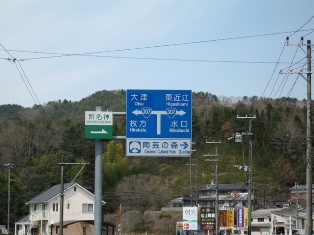 At the bottom of the down hill, you will enter a small village. Then there will be another small hill with a wider road. Soon, you will come to an intersection. Turn left here and continue to ride about 8 km. Then you will arrive at an intersection of Tateishibashi (立石橋) which merges to National Route #307.  When you turn right at this intersection, you will be welcomed by the Raccoons! If you do not have time to spend in Shigaraki, you can turn left at the Tateishibashi intersection. The National Route #307 will take you to Ujitawara (宇治田原) in Kyoto prefecture.  The many workshops here are famous for making ceramic raccoons. This is the Shigaraki! The price of the ceramic work at these shops is quite reasonable, and almost all the shops can arrange shipment to foreign countries (extra charge, of course).  After riding about 2 km from Tateishibashi (立石橋), you will come across the intersection Nagano (長野). Turn left here. Enjoy ceramic viewing and shopping The course will soon reach to intersection. You can turn right to the Shigaraki Kougen Station (信楽高原駅) in the center of Shigaraki. Along the street to the station, there are many ceramic workshops. 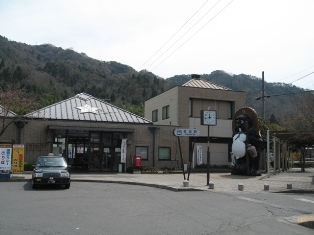
After you’ve enjoyed the ceramics and completed your shopping, it’s time to pedal on to Kyoto. Shigaraki to Uji 31 kmGate to KyotoThe fourth section of LOJ from Toba to Kyoto is the route connecting Shigaraki of Shiga prefecture and Uji city of Kyoto prefecture. The course will use the National Route #307 to the west, in the direction of the Tateishibashi (立石橋). It is 31 km from Shigaraki to Uji city, the entrance of Kyoto.  Most of the National Route #307 is very convenient for riding. You will soon see tea plantations along the course. 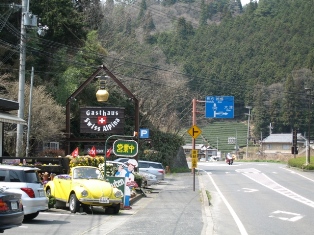 When you reach to the Swiss restaurant at Asamiya (朝宮), the course will turn up hill to Urajiro pass, the final approach to Kyoto, (裏白峠). Ujicha (宇治茶) The up hill is only 3 km, at an altitude of 387 m. The peak of the pass is the borderline between the Shiga and Kyoto prefectures. The course then enters Ujitawara(宇治田原), one town before Uji city. During down hill to Ujitawara, you will pass more tea plantations. Ujitawara is famous for a tea called Ujicha (宇治茶), which is gown throught the region. 
 When the National Route #307 enters into the center of Ujitawara, the traffic will be heavier. Take the old road beside the National Route #307 at the intersection about 8 km from the Urajiro pass. Continue to ride straight into the residential area of Ujitawara. Take the route to Amagase-dam (天ヶ瀬ダム) at the intersection. The Amagase-dam Lake will be in your view about 2 km from Ujitawara. Go straight along with the lake on your right. Amagase-dam (天ヶ瀬ダム)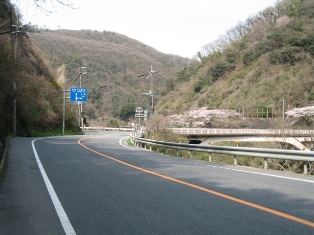 You will arrive Amagase-sam (天ヶ瀬ダム) soon. 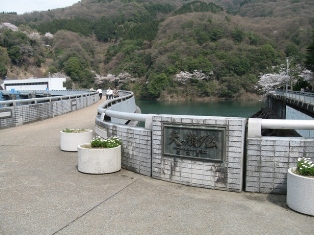 Amagase-dam is used for supplying the water to Uji-city, flood control and power generation (598,000 kW). This dam is also a good sightseeing spot in Uji-city. Byodo-in 平等院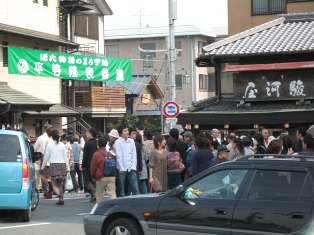 Another 2 km ride will bring you to the Uji city, the goal of this section. When you will see a big parking lot on your left, you are in Uji, Kyoto and the famous Byoudouin (平等院) is just in front of you.
If your destination is in Kyoto city, the easiest route is to take the road along the bank of Uji river (宇治川) to Kangetu bridge (観月橋). Then take the National Route #24 to north. But depending on your destination in Kyoto, you can take many different routes from Uji to the center of Kyoto.
uploaded:07, 04, 2019 |
|
|
|
Copyright "Japan Cycling Navigator". All
rights reserved.
|


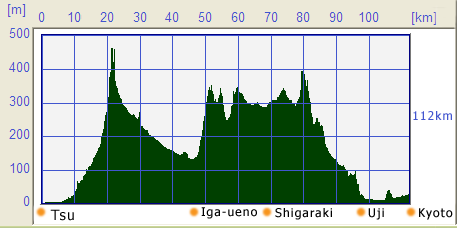
 Iga Ueno Castle[E]
Iga Ueno Castle[E]